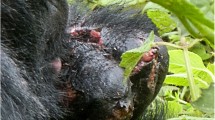Abstract
Chimpanzees, bonobos, and human foragers share a fission-fusion social system and a mating system of joint male resource defense polygyny. Within-community skew in male strength varies among and within species. In this study, we extend a mathematical model of within-group male coalition formation among primates to derive the conditions for between-community conflicts in the form of raids. We show that the main factor affecting the presence of successful raiding is the likelihood of major discrepancies in party strength, which are set by party size distributions (and thus community size) and the skew in strength. This study confirms the functional similarities between the raiding of chimpanzees and human foragers, and it supports the “imbalance of power” hypothesis for raiding. However, it also proposes two amendments to this model. First, the absence of raiding in bonobos may be attributable more to potential female involvement in defense against raids, which increases the size of defensive coalitions. Second, the model attributes some of the raiding in humans to major contrasts in instantaneous fighting ability created by surprise raids on unarmed victims; it also draws attention to the distinction between minor raids and major raids that involve multiple bands of the same community.

Similar content being viewed by others
References
Amsler, S. (2010). Energetic costs of territorial boundary patrols by wild chimpanzees. American Journal of Primatology, 72, 93–103.
Aureli, F., Schaffner, C. M., Verpooten, J., Slater, K., & Ramos-Fernandez, G. (2006). Raiding parties of male spider monkeys: insights into human warfare. American Journal of Physical Anthropology, 131, 486–497.
Bissonnette, A., de Vries, H., & van Schaik, C. P. (2009). Coalitions in male Barbary macaques, Macaca sylvanus: strength, success and rules of thumb. Animal Behaviour, 78, 329–335.
Boehm, C. (1999). Hierarchy in the forest: Egalitarianism and the evolution of human altruism. Cambridge: Harvard University Press.
Boesch, C., & Boesch-Achermann, H. (2000). The chimpanzees of the Taï Forest: Behavioral ecology and evolution. New York: Oxford University Press.
Boesch, C., Crockford, C., Herbinger, I., Wittig, R., Moebius, Y., & Normand, E. (2008). Intergroup conflicts among chimpanzees in Taï National Park: lethal violence and the female perspective. American Journal of Primatology, 70, 519–532.
Borgerhoff Mulder, M., Bowles, S., Hertz, T., et al. (2009). Intergenerational wealth transmission and the dynamics of inequality in small-scale societies. Science, 326, 682–688.
Cheney, D. L. (1987). Interactions and interrelationships between groups. In B. B. Smuts, D. L. Cheney, R. M. Seyfarth, R. W. Wrangham, & T. T. Struhsaker (Eds.), Primate societies (pp. 477–490). Chicago: University of Chicago Press.
Dediu, D., & Levinson, S. (2013). On the antiquity of language: the reinterpretation of Neandertal linguistic capacities and its consequences. Frontiers in Psychology, 4, 397.
Diamond, J. (2012). The world until yesterday: What can we learn from traditional societies? New York: Penguin.
Emlen, S., & Oring, L. (1977). Ecology, sexual selection and evolution of mating systems. Science, 197, 215–222.
Fry, D. (2007). Beyond war: The human potential for peace. New York: Oxford University Press.
Furuichi, T. (2009). Factors underlying party size differences between chimpanzees and bonobos: a review and hypothesis for future studies. Primates, 50, 197–209.
Furuichi, T. (2011). Female contributions to the peaceful nature of bonobo society. Evolutionary Anthropology, 20, 131–142.
Gat, A. (2006). War in human civilization. New York: Oxford University Press.
Gerloff, U., Hartung, B., Fruth, B., Hohmann, G., & Tautz, D. (1999). Intracommunity relationships, dispersal pattern and paternity success in a wild living community of bonobos (Pan paniscus) determined from DNA analysis of faecal samples. Proceedings of the Royal Society of London B: Biological Sciences, 266, 1189–1195.
Gilby, I., Wilson, M., & Pusey, A. (2013). Ecology rather than psychology explains co-occurrence of predation and border patrols in male chimpanzees. Animal Behaviour, 86, 61–74.
Gintis, H., van Schaik, C. P., & Boehm, C. (2015). Zoon politikon: the evolutionary origins of human political systems. Current Anthropology, 56, 327–353.
Glowacki, L., & Wrangham, R. (2013). The role of rewards in motivating participation in simple warfare. Human Nature, 24, 444–460.
Glowacki, L., & Wrangham, R. (2015). Warfare and reproductive success in a tribal population. Proceedings of the National Academy of Sciences of the United States of America, 112, 348–353.
Goodall, J. (1986). The chimpanzees of Gombe: Patterns of behavior. Cambridge: Belknap.
Hohmann, G., & Fruth, B. (2002). Dynamics in social organization of bonobos (Pan paniscus). In C. Boesch, G. Hohmann, & L. F. Marchant (Eds.), Behavioral diversity in chimpanzees and bonobos (pp. 138–150). Cambridge: Cambridge University Press.
Keeley, L. H. (1996). War before civilization. New York: Oxford University Press.
Langergraber, K., Mitani, J., Watts, D., & Vigilant, L. (2007). The limited impact of kinship on cooperation in wild chimpanzees. Proceedings of the National Academy of Sciences of the United States of America, 104, 7786–7790.
Langergraber, K., Schubert, G., Rowney, C., Wrangham, R., Zommers, Z., & Vigilant, L. (2011). Genetic differentiation and the evolution of cooperation in chimpanzees and humans. Proceedings of the Royal Society B: Biological Sciences, 278, 2546–2552.
Layton, R., O’Hara, S., & Bilsborough, A. (2012). Antiquity and social functions of multilevel social organization among human hunter-gatherers. International Journal of Primatology, 33, 1215–1245.
LeBlanc, S. (2003). Constant battles: The myth of the peaceful, noble savage. New York: St. Martin’s Press.
Lehmann, J., & Boesch, C. (2004). To fission or to fusion: effect of community size on wild chimpanzee (Pan troglodytes verus) social organisation. Behavioral Ecology and Sociobiology, 56, 207–216.
Liddle, J. R., Shackelford, T. K., & Weekes-Shackelford, V. A. (2012). Why can’t we all just get along? Evolutionary perspectives on violence, homicide, and war. Review of General Psychology, 16, 24–36.
Macfarlan, S. J., Walker, R. S., Flinn, N. V., & Chagnon, N. A. (2014). Lethal coalitionary aggression and long-term alliance formation among Yanomamo males. Proceedings of the National Academy of Sciences of the United States of America, 111(47), 16662–16669.
Manson, J. H., & Wrangham, R. W. (1991). Intergroup aggression in chimpanzees and humans. Current Anthropology, 32, 369–390.
Marlowe, F. (2010). The Hadza: Hunter-gatherers of Tanzania. Berkely: Univesity of California Press.
Maynard Smith, J., & Parker, G. A. (1990). Optimality theory in evolutionary biology. Nature, 348, 27–33.
Mitani, J. C., Watts, D., & Amsler, S. J. (2010). Lethal intergroup aggression leads to territorial expansion in wild chimpanzees. Current Biology, 12, R507–R508.
Nishida, T., Haraiwa-Hasegawa, M., & Takahata, Y. (1985). Group extinction and female transfer in wild chimpanzees in the Mahale National Park, Tanzania. Zeitschrift für Tierpsychologie, 67, 284–301.
Noë, R. (1994). A model of coalition formation among male baboons with fighting ability as the crucial parameter. Animal Behaviour, 47, 211–213.
Otterbein, K. F. (2004). How war began. College Station: Texas A&M University Press.
Palombit, R. A. (1993). Lethal territorial aggression in a white-handed gibbon. American Journal of Primatology, 31, 311–318.
Pandit, S. A., & van Schaik, C. P. (2003). A model for leveling coalitions among male primates: towards a theory of egalitarianism. Behavioral Ecology and Sociobiology, 55, 161–168.
Pradhan, G. R., Pandit, S. A., & van Schaik, C. P. (2014). Why do chimpanzee males attack the females of neighboring communities? American Journal of Physical Anthropology, 155, 430–435.
Robarchek, C. A. (1989). Primitive warfar and the ratomorphic image of mankind. American Anthropologist, 91, 903–920.
Rodseth, L., Wrangham, R. W., Harrigan, A. M., & Smuts, B. B. (1991). The human community as a primate society. Current Anthropology, 32, 221–254.
Rusch, H. (2014). The two sides of warfare An extended model of altruistic behavior in ancestral human inter-group conflict. Human Nature, 25, 359–377.
Smuts, B. B. (1987). Gender, aggression, and influence. In B. B. Smuts, D. L. Cheney, R. M. Seyfarth, R. W. Wrangham, & T. T. Struhsaker (Eds.), Primate societies (pp. 400–412). Chicago: University of Chicago Press.
Stevens, J. M. G., Vervaecke, H., & van Elsacker, L. (2008). The bonobo’s adaptive potential: Social relations under captive conditions. In T. Furuichi & J. Thompson (Eds.), The Bonobos: Behavior, ecology and, conservation (pp. 19–38). New York: Springer.
Surbeck, M., & Hohmann, G. (2008). Primate hunting by bonobos at LuiKotale, Salonga National Park. Current Biology, 18, R906–R907.
Surbeck, M., Mundry, R., & Hohmann, G. (2011). Mothers matter: Maternal support, dominance status and mating success in male bonobos (Pan paniscus). Proceedings of the Royal Society B: Biological Sciences, 278, 590–598.
Thorpe, I. J. N. (2003). Anthropology, archaeology, and the origin of warfare. World Archaeology, 35, 145–165.
Trivers, R. L. (1972). Parental investment and sexual selection. In B. Campbell (Ed.), Sexual selection and the descent of man 1871–1971 (pp. 136–179). Chicago: Aldine.
van der Dennen, J. M. G. (1995). The origin of war: The evolution of a male-coalitional reproductive strategy. Groningen: Origin Press.
van Schaik, C. P., Pandit, S. A., & Vogel, E. R. (2006). Toward a general model for male-male coalitions in primate groups. In P. M. Kappeler & C. P. van Schaik (Eds.), Cooperation in primates and humans: Mechanisms and evolutions (pp. 151–171). Berlin: Springer.
Vervaecke, H., de Vries, H., & van Elsacker, L. (2000). Dominance and its behavioral measures in a captive group of bonobos (Pan paniscus). International Journal of Primatology, 21, 47–68.
Watts, D. P., & Mitani, J. C. (2002). Hunting behavior of chimpanzees at Ngogo, Kibale National Park, Uganda. International Journal of Primatology, 23, 1–28.
Wilkins, J., Schoville, B. J., Brown, K. S., et al. (2012). Evidence for early hafted hunting technology. Science, 338, 942–946.
Willems, E. P., Hellriegel, B., & van Schaik, C. P. (2013). The collective action problem in primate territory economics. Proceedings of the Royal Society of London B: Biological Sciences, 280, 1–7.
Wilson, M. L. (2013). Chimpanzees, warfare and the invention of peace. In D. Fry (Ed.), War, peace and human nature: The convergence of evolutionary and cultural views (pp. 361–388). New York: Oxford University Press.
Wilson, M. L., & Wrangham, R. W. (2003). Intergroup relations in chimpanzees. Annual Review of Anthropology, 32, 363–392.
Wilson, M. L., Hauser, M. D., & Wrangham, R. W. (2001). Does participation in intergroup conflict depend on numerical assessment, range location, or rank for wild chimpanzees? Animal Behaviour, 61, 1203–1216.
Wilson, M. L., Britton, N. F., & Franks, N. R. (2002). Chimpanzees and mathematics of battle. Proceedings of the Royal Society B: Biological Sciences, 269, 1107–1112.
Wilson, M. L., Boesch, C., Fruth, B., et al. (2014). Lethal aggression in Pan is better explained by adaptive strategies than human impacts. Nature, 513, 414–417.
Wrangham, R. W. (1986). Ecology and social relationships in two species of chimpanzees. In D. Rubenstein & R. Wrangham (Eds.), Ecological aspects of social evolution birds and mammals (pp. 352–378). Princeton: Princeton University Press.
Wrangham, R. W. (1999). Evolution of coalitionary killing. Yearbook of Physical Anthropology, 42, 1–30.
Wrangham, R. W. (2002). The cost of sexual attraction: Is there is a trade-off in female Pan between sex appeal and received coercion? In C. Boesch, G. Hohmann, & L. Marchant (Eds.), Behavioural diversity in chimpanzees and bonobos (pp. 204–215). New York: Cambridge University Press.
Wrangham, R. W., & Glowacki, L. (2012). Intergroup aggression in chimpanzees and war in nomadic hunter-gatherers: evaluating the chimpanzee model. Human Nature, 23, 5–29.
Acknowledgments
CvS and GRP thank A.H. Schultz Foundation for financial support. The authors also thank the anonymous reviewers for comments on the earlier version of the manuscript.
Author information
Authors and Affiliations
Corresponding author
Rights and permissions
About this article
Cite this article
Pandit, S.A., Pradhan, G.R., Balashov, H. et al. The Conditions Favoring Between-Community Raiding in Chimpanzees, Bonobos, and Human Foragers. Hum Nat 27, 141–159 (2016). https://doi.org/10.1007/s12110-015-9252-5
Published:
Issue Date:
DOI: https://doi.org/10.1007/s12110-015-9252-5




